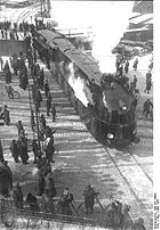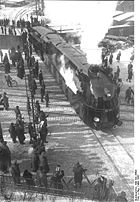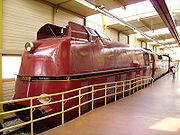
DRG Class 05
Encyclopedia
The Deutsche Reichsbahn
's Class 05 was a German
class of three express passenger steam locomotive
s of 4-6-4
wheel arrangement
in the Whyte notation
, or 2'C2' in the UIC notation used in continental Europe. They were part of the DRG's standard locomotive (Einheitslokomotive
) series.
 Since the success of the Diesel
Since the success of the Diesel
high speed trains
like the Flying Hamburger
in the middle of the 1930s, locomotive industry worked on faster steam locomotive
s. After speed tests with a streamlined
DRG Class 03
the Borsig locomotive factorysThe Borsig factory was moved from Tegel to Hennigdorf after the takeover of Borsig by AEG
, and production took place at both sites produced three engines:
The locomotives did regular service in FD express passenger trains, e.g. FD 23 from Hamburg
to Berlin
.
The design speed was 175 km/h (109 mph). In 1944, the streamline plates were removed. 05 003 had been rebuilt and lost the cab forward design.
after reaching 200.4 km/h (124.5 mph) on the Berlin–Hamburg line hauling a 197 t train. The engine power was more than 2,535 kW (3,400 ihp
). This record was broken two years later by the British LNER Class A4 4468 Mallard
engine.
On May 30, 1936 the 05 002 set an unbroken start stop speed record for steam locomotives: During the return run from a 190 km/h test Berlin-Hamburg it did the ~113 kilometres (70.1 miles) from Wittenberge to a signal stop before Berlin-Spandau in 48 min 32 s, meaning 139.4 km/h (86.66 mph) average between start and stop.
 After World War II, the three engines came to the engine shop in Hamm
After World War II, the three engines came to the engine shop in Hamm
, Westfalia
. Since there were only three specimens of the 05, DB
thought to scrap them. But then the engines were sent to Krauss-Maffei
to be restored. 05 003 went into regular service in 1950, the other two in 1951. Boiler pressure was reduced to 16 bar (1600 kPa or 230 lbf/in²), hence the engines lost some of their old power. All three locomotives were used to haul express trains until 1958.
Mostly the 05 hauled the FD (long distance express) trains "Hanseat" and "Domspatz" on the run Hamburg
- Cologne
- Frankfurt
. The regular top speed of the trains was 140 km/h. On this 703 km run the 05 operated trains did the longest run with steam traction in the DB network. July 1958 the 05 were replaced by the diesel-hydraulic DB class V 200
.
05 001 went to the Verkehrsmuseum Nürnberg, where it can be seen streamlined with its original red livery. The other two locomotives were scrapped in 1960.
Deutsche Reichsbahn
Deutsche Reichsbahn was the name of the following two companies:* Deutsche Reichsbahn, the German Imperial Railways during the Weimar Republic, the Third Reich and the immediate aftermath...
's Class 05 was a German
Germany
Germany , officially the Federal Republic of Germany , is a federal parliamentary republic in Europe. The country consists of 16 states while the capital and largest city is Berlin. Germany covers an area of 357,021 km2 and has a largely temperate seasonal climate...
class of three express passenger steam locomotive
Steam locomotive
A steam locomotive is a railway locomotive that produces its power through a steam engine. These locomotives are fueled by burning some combustible material, usually coal, wood or oil, to produce steam in a boiler, which drives the steam engine...
s of 4-6-4
4-6-4
Under the Whyte notation for the classification of steam locomotives, 4-6-4 represents the wheel arrangement of four leading wheels on two axles , six powered and coupled driving wheels on three axles, and four trailing wheels on two axles .Other equivalent classifications are:UIC classification:...
wheel arrangement
Wheel arrangement
In rail transport, a wheel arrangement is a system of classifying the way in which wheels are distributed beneath a locomotive.. Several notations exist to describe the wheel assemblies of a locomotive by type, position, and connections, with the adopted notations varying by country...
in the Whyte notation
Whyte notation
The Whyte notation for classifying steam locomotives by wheel arrangement was devised by Frederick Methvan Whyte and came into use in the early twentieth century encouraged by an editorial in American Engineer and Railroad Journal...
, or 2'C2' in the UIC notation used in continental Europe. They were part of the DRG's standard locomotive (Einheitslokomotive
Einheitsdampflokomotive
The German term Einheitsdampflokomotive, sometimes shortened to Einheitslokomotive or Einheitslok, means standard steam locomotive and refers to the steam engines built in Germany after 1925 under the direction of the Deutsche Reichsbahn-Gesellschaft...
) series.
Pre WWII history

Diesel locomotive
A diesel locomotive is a type of railroad locomotive in which the prime mover is a diesel engine, a reciprocating engine operating on the Diesel cycle as invented by Dr. Rudolf Diesel...
high speed trains
High-speed rail
High-speed rail is a type of passenger rail transport that operates significantly faster than the normal speed of rail traffic. Specific definitions by the European Union include for upgraded track and or faster for new track, whilst in the United States, the U.S...
like the Flying Hamburger
DRG Class SVT 877
The DRG Class SVT 877 Hamburg Flyer – sometimes also Flying Hamburger or in German Fliegender Hamburger – was Germany's first fast diesel train, and is credited with establishing the fastest regular railway connection in the world in its time...
in the middle of the 1930s, locomotive industry worked on faster steam locomotive
Steam locomotive
A steam locomotive is a railway locomotive that produces its power through a steam engine. These locomotives are fueled by burning some combustible material, usually coal, wood or oil, to produce steam in a boiler, which drives the steam engine...
s. After speed tests with a streamlined
Streamliner
A streamliner is a vehicle incorporating streamlining in a shape providing reduced air resistance. The term is applied to high-speed railway trainsets of the 1930s to 1950s, and to their successor "bullet trains". Less commonly, the term is applied to fully faired recumbent bicycles...
DRG Class 03
DRG Class 03
The Class 03 steam engines were standard express train locomotives in service with the Deutsche Reichsbahn.- History :...
the Borsig locomotive factorysThe Borsig factory was moved from Tegel to Hennigdorf after the takeover of Borsig by AEG
AEG
Allgemeine Elektricitäts-Gesellschaft was a German producer of electrical equipment founded in 1883 by Emil Rathenau....
, and production took place at both sites produced three engines:
- 05 001 in 1935, streamlined,
- 05 002 in 1935, streamlined, world speed record in 1936
- 05 003 in 1937, cab forwardCab forwardThe term cab forward refers to various rail and road vehicle designs which place the driver's compartment substantially farther towards the front than is common practice.- Rail locomotives :...
streamlined.
The locomotives did regular service in FD express passenger trains, e.g. FD 23 from Hamburg
Hamburg
-History:The first historic name for the city was, according to Claudius Ptolemy's reports, Treva.But the city takes its modern name, Hamburg, from the first permanent building on the site, a castle whose construction was ordered by the Emperor Charlemagne in AD 808...
to Berlin
Berlin
Berlin is the capital city of Germany and is one of the 16 states of Germany. With a population of 3.45 million people, Berlin is Germany's largest city. It is the second most populous city proper and the seventh most populous urban area in the European Union...
.
The design speed was 175 km/h (109 mph). In 1944, the streamline plates were removed. 05 003 had been rebuilt and lost the cab forward design.
World high speed records
05 001 and 05 002 were mainly used for test runs from 1935 to 1936. Most of these runs were made on complete journeys between Hamburg and Berlin. On June 7, 1935 the 05 002 made a top speed of 191.7 km/h (119.1 mph) near Berlin. The same engine made six more runs with more than 177 km/h (110 mph) with trains up to 254 t weight. On May 11, 1936 it set the world speed record for steam locomotivesLand speed record for railed vehicles
Determination of the fastest rail vehicle in the world varies depending on the definition of "rail".Official absolute world record for conventional train is held by the French TGV...
after reaching 200.4 km/h (124.5 mph) on the Berlin–Hamburg line hauling a 197 t train. The engine power was more than 2,535 kW (3,400 ihp
IHP
IHP is a three letter acronym that can stand for:*International Hydrological Programme*Indicated horsepower*Innovations for High Performance Microelectronics, a German institute and part of the Gottfried Wilhelm Leibniz Scientific Community...
). This record was broken two years later by the British LNER Class A4 4468 Mallard
LNER Class A4 4468 Mallard
Number 4468 Mallard is a London and North Eastern Railway Class A4 4-6-2 Pacific steam locomotive built at Doncaster, England in 1938. While in other respects a relatively typical member of its class, it is historically significant for being the holder of the official world speed record for steam...
engine.
On May 30, 1936 the 05 002 set an unbroken start stop speed record for steam locomotives: During the return run from a 190 km/h test Berlin-Hamburg it did the ~113 kilometres (70.1 miles) from Wittenberge to a signal stop before Berlin-Spandau in 48 min 32 s, meaning 139.4 km/h (86.66 mph) average between start and stop.
Post-War history

Hamm
Hamm is a city in North Rhine-Westphalia , Germany. It is located in the northeastern part of the Ruhr area. As of December 2003 its population was 180,849. The city is situated between the A1 motorway and A2 motorway...
, Westfalia
Westfalia
Westfalia is the designation of various specially converted Volkswagen camper vans. It is named after Westfalia-Werke, the contractor that built the vans, which is headquartered in the town of Rheda-Wiedenbrück located in the Westphalia region of Germany....
. Since there were only three specimens of the 05, DB
Deutsche Bundesbahn
The Deutsche Bundesbahn or DB was formed as the state railway of the newly established Federal Republic of Germany on September 7, 1949 as a successor of the Deutsche Reichsbahn-Gesellschaft '...
thought to scrap them. But then the engines were sent to Krauss-Maffei
Krauss-Maffei
The Krauss-Maffei Wegmann GmbH & Co KG or simply Krauss-Maffei is an injection molding machine manufacturer and defence company based in Munich, Germany...
to be restored. 05 003 went into regular service in 1950, the other two in 1951. Boiler pressure was reduced to 16 bar (1600 kPa or 230 lbf/in²), hence the engines lost some of their old power. All three locomotives were used to haul express trains until 1958.
Mostly the 05 hauled the FD (long distance express) trains "Hanseat" and "Domspatz" on the run Hamburg
Hamburg
-History:The first historic name for the city was, according to Claudius Ptolemy's reports, Treva.But the city takes its modern name, Hamburg, from the first permanent building on the site, a castle whose construction was ordered by the Emperor Charlemagne in AD 808...
- Cologne
Cologne
Cologne is Germany's fourth-largest city , and is the largest city both in the Germany Federal State of North Rhine-Westphalia and within the Rhine-Ruhr Metropolitan Area, one of the major European metropolitan areas with more than ten million inhabitants.Cologne is located on both sides of the...
- Frankfurt
Frankfurt
Frankfurt am Main , commonly known simply as Frankfurt, is the largest city in the German state of Hesse and the fifth-largest city in Germany, with a 2010 population of 688,249. The urban area had an estimated population of 2,300,000 in 2010...
. The regular top speed of the trains was 140 km/h. On this 703 km run the 05 operated trains did the longest run with steam traction in the DB network. July 1958 the 05 were replaced by the diesel-hydraulic DB class V 200
DB class V 200
DB Class V 200.0 was one of the first diesel-hydraulic express locomotives of the German Deutsche Bundesbahn and - as Am 4/4 - of the SBB-CFF-FFS in Switzerland.-DB Service:...
.
05 001 went to the Verkehrsmuseum Nürnberg, where it can be seen streamlined with its original red livery. The other two locomotives were scrapped in 1960.
External links
- http://www.germansteam.co.uk/FastestLoco/fastestloco.html
- http://www.ewetel.net/~michael.blunck/ttd/br05_1.html
- http://www.aqpl43.dsl.pipex.com/MUSEUM/LOCOLOCO/05003/05003.htm cab forward 05 003
- http://www.dbtrains.com/en/locomotives/epochII/BR05
- http://www.dlok.de/87.htm Specifications source (in German)

